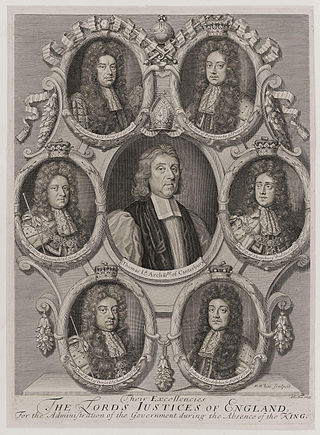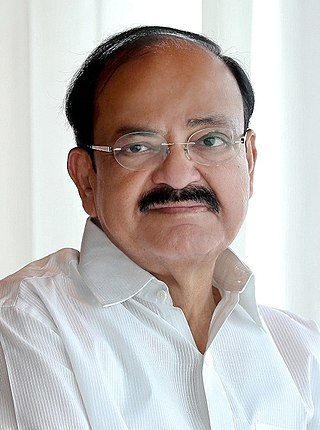The Fourth Annual State of Indian Nations Address was delivered by National Congress of American Indians president Joe Garcia on February 2, 2006, at 12:00 p.m. (EST) at the National Press Club, two days after United States President George W. Bush gave his 2006 State of the Union address.

William Henry Harrison was an American military officer and politician who served as the ninth president of the United States. Harrison died just 31 days after his inauguration in 1841, the shortest presidency in United States history. He was also the first United States president to die in office, and a brief constitutional crisis resulted as presidential succession was not then fully defined in the United States Constitution. Harrison was the last president born as a British subject in the Thirteen Colonies and was the paternal grandfather of Benjamin Harrison, the 23rd president of the United States.

Kocheril Raman Narayananlisten (help·info) was an Indian statesman, diplomat, academic, and politician who served as the ninth vice president of India from 1992 to 1997 and tenth president of India from 1997 to 2002.

The president of India is the head of state of the Republic of India. The president is the nominal head of the executive, the first citizen of the country, as well as the commander-in-chief of the Indian Armed Forces. Droupadi Murmu is the 15th and current president, having taken office from 25 July 2022.

Sonia Gandhi is an Indian politician of Italian origin. She is the longest serving president of the Indian National Congress, a social democratic political party, which has governed India for most of its post-independence history. She took over as the party leader in 1998, seven years after the assassination of Rajiv Gandhi, her husband and a former Prime Minister of India, and remained in office until 2017 after serving for twenty-two years. She returned to the post in 2019 and remained the President for another three years.

The Indian Removal Act was signed into law on May 28, 1830, by United States President Andrew Jackson. The law, as described by Congress, provided "for an exchange of lands with the Indians residing in any of the states or territories, and for their removal west of the river Mississippi." During the Presidency of Jackson (1829-1837) and his successor Martin Van Buren (1837-1841) more than 60,000 Indians from at least 18 tribes were forced to move west of the Mississippi River where they were allocated new lands. The southern tribes were resettled mostly in Indian Territory (Oklahoma). The northern tribes were resettled initially in Kansas. With a few exceptions the United States east of the Mississippi and south of the Great Lakes was emptied of its Indian population. The movement westward of the Indian tribes was characterized by a large number of deaths occasioned by the hardships of the journey.

Excellency is an honorific style given to certain high-level officers of a sovereign state, officials of an international organization, or members of an aristocracy. Once entitled to the title "Excellency", the holder usually retains the right to that courtesy throughout their lifetime, although in some cases the title is attached to a particular office, and is held only for the duration of that office.

The Constitution of India is the supreme law of India. The document lays down the framework that demarcates fundamental political code, structure, procedures, powers, and duties of government institutions and sets out fundamental rights, directive principles, and the duties of citizens. It is the longest written national constitution in the world.

Pieter Willem Botha, was a South African politician. He served as the last prime minister of South Africa from 1978 to 1984 and the first executive state president of South Africa from 1984 to 1989.

The Parliament of India is the supreme legislative body of the Republic of India. It is a bicameral legislature composed of the president of India and two houses: the Rajya Sabha and the Lok Sabha. The president in his role as head of the legislature has full powers to summon and prorogue either house of Parliament or to dissolve the Lok Sabha. The president can exercise these powers only upon the advice of the prime minister and his Union Council of Ministers.

Muppavarapu Venkaiah Naidu is an Indian politician who served as the 13th vice president of India from 2017 to 2022. He is the first Indian vice president born in independent India. He has also served as the minister of Housing and Urban Poverty Alleviation, Urban Development and Information and Broadcasting in the Modi Cabinet.
The Government of India, known as the Union Government or Central Government but often simply as the Centre, is the national authority of the Republic of India, a federal democracy located in South Asia, consisting of 28 union states and eight union territories. Under the Constitution, there are three primary branches of government: the legislative, the executive and the judiciary, whose powers are vested in a bicameral Parliament, President, aided by the Council of Ministers, and the Supreme Court respectively. Through judicial evolution, the Parliament has lost its sovereignty as its amendments to the Constitution are subject to judicial intervention. Judicial appointments in India are unique in that the executive or legislature have negligible say.

The national flag of India, colloquially called the tricolour, is a horizontal rectangular tricolour flag of India saffron, white and India green; with the Ashoka Chakra, a 24-spoke wheel, in navy blue at its centre. It was adopted in its present form during a meeting of the Constituent Assembly held on 22 July 1947, and it became the official flag of the Dominion of India on 15 August 1947. The flag was subsequently retained as that of the Republic of India. In India, the term "tricolour" almost always refers to the Indian national flag. The flag is based on the Swaraj flag, a flag of the Indian National Congress designed by Pingali Venkayya.

The Parliament House in New Delhi is the seat of the Parliament of India. Its houses the Lok Sabha and the Rajya Sabha which represent lower and upper houses respectively in India's bicameral parliament.
The governors of the states of India have similar powers and functions at the state level as those of the president of India at the central level. Governors exist in the states, while lieutenant governors exist in union territories including the National Capital Territory (NCT) of Delhi. The governor acts as the nominal head whereas the real power lies with the chief ministers of the states and his or her councils of ministers. Although, in union territories, the real power lies with the lieutenant governor or administrator, except in the NCT of Delhi and Puducherry, where the governor shares power with a council of ministers headed by a chief minister. Few or no governors are local to the state that they are appointed.

The 2006 State of the Union Address was given by the 43rd president of the United States, George W. Bush, on January 31, 2006, at 9:00 p.m. EST, in the chamber of the United States House of Representatives to the 109th United States Congress. It was Bush's fifth State of the Union Address and his sixth speech to a joint session of the United States Congress. Presiding over this joint session was the House speaker, Dennis Hastert, accompanied by Dick Cheney, the vice president, in his capacity as the president of the Senate.

Bhishma Narain Singh was an Indian politician who served as the Governor of Assam from 1984 to 1989 and Governor of Tamil Nadu from 1991 to 1993.
Joe DeLaCruz was a Native American leader in Washington, U.S., president for 22 years of the Quinault Tribe. He was reputed for his "thorough, in-depth knowledge of probably every Indian tribe in North America." According to Suzan Harjo, "His programs became models for Native Americans everywhere."

P. S. Sreedharan Pillai is an Indian politician, attorney, and author, who is currently serving as the 19th and current Governor of Goa since 2021. He also served as the Governor of Mizoram from 2019 to 2021, he was also the Bharatiya Janata Party president of Kerala state from 2003 to 2006 and again from 2018 to 2019.
The United States public policy agenda on issues affecting Native Americans under the Obama administration includes the signing of the Tribal Law and Order Act of 2010, which allowed tribal courts to extend and expand sentences handed down to them in criminal cases, strengthening tribal autonomy. Obama also supported and enforced the Executive Order 13175, which requires the federal government to consult with tribal governments when deliberating over policies and programs that would affect tribal communities. Under the Obama Administration was also the launching of Michelle Obama's program Let's Move In Indian Country, which aims to improve opportunities for physical activity, to increase access to healthy food in tribal communities, and to create collaborations between private and public sectors to build programs that will end childhood obesity in Native communities. Obama also supported tribal communities through certain provisions of the American Recovery and Reinvestment Act of 2009, which allocated $510 million for rehabilitation of Native American housing, and the settlement of the Keepseagle case, a lawsuit against the United States Department of Agriculture for discriminating against tribal communities by not allowing them equal access to the USDA Farm Loan Program. Most recently, Obama signed Executive Order 13592, which seeks to improve educational opportunities for American Indian and Alaska Natives. Obama has been praised by many tribal leaders, including those who claim he has done more for Native Americans than all of his predecessors combined.

Mohan Kameswaran is an Indian otorhinolaryngologist, medical academic and the founder of MERF Institute of Speech and Hearing, a Chennai-based institution providing advanced training in audiology and speech-language pathology. He is one of the pioneers of cochlear implant surgery in India and a visiting professor at Rajah Muthiah Medical College of the Annamalai University and Sri Ramachandra Medical College and Research Institute, Chennai. He has many firsts to his credit such as the performance of the first auditory brain stem implantation surgery in South and South East Asia, the first pediatric brain stem implantation surgery in Asia, the first totally implantable hearing device surgery in Asia Pacific region, and the first to introduce KTP/532 laser-assisted ENT surgery in India. The Government of India awarded him the fourth highest civilian honour of the Padma Shri, in 2006, for his contributions to Indian medicine.